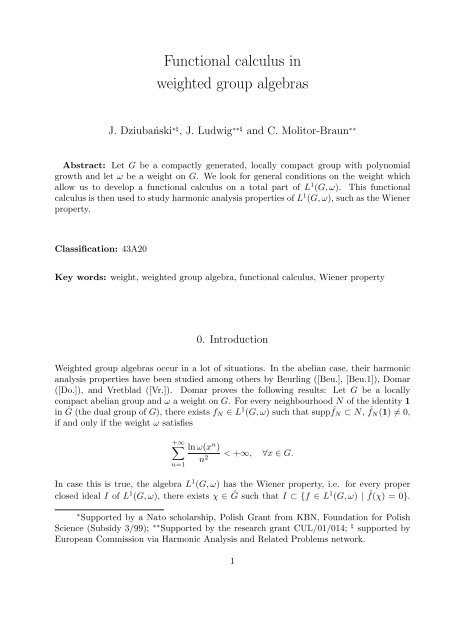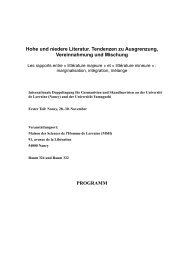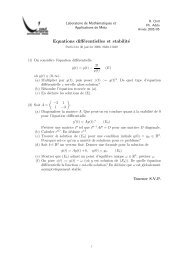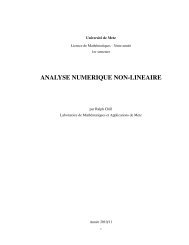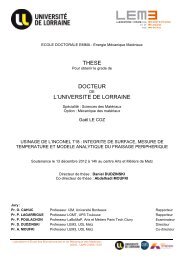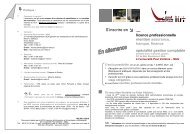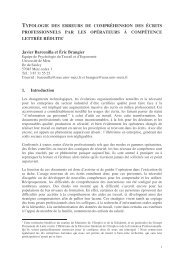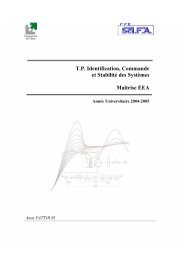Functional calculus in weighted group algebras
Functional calculus in weighted group algebras
Functional calculus in weighted group algebras
You also want an ePaper? Increase the reach of your titles
YUMPU automatically turns print PDFs into web optimized ePapers that Google loves.
For the <strong>group</strong> G = R, Vretblad even proves a partial converse of the Wiener property. Heshows the follow<strong>in</strong>g: Let ω be a symmetric weight on R such that∫Rln ω(x)dx = ∞.1 + x2 Assume moreover that ω(x) = exp( π 2 |x|q(x)) with q decreas<strong>in</strong>g on R + and ω <strong>in</strong>creas<strong>in</strong>gon R + . Then L 1 (R, ω) does not have the Wiener property. Let’s write nx <strong>in</strong>stead of x n ,as the <strong>group</strong> R is additive. Notice that under the assumptions on q and ω,+∞∑n=1ln ω(nx)n 2 < +∞ ∀x ∈ R ⇐⇒∫Rln ω(x)dx < +∞.1 + x2 Hence Vretblad shows that if L 1 (R, ω) has the Wiener property, then ∑ +∞ ln ω(nx)n=1 n< +∞,2for every x ∈ R. The aim of the present paper consists <strong>in</strong> prov<strong>in</strong>g similar results for nonabelian <strong>group</strong>s. Let G be a locally compact <strong>group</strong> and Ĝ its dual, i.e. the space ofequivalence classes of unitary topologically irreducible representations of G. The questionabout Domar’s property is then the follow<strong>in</strong>g: Let N be an arbitrary open set <strong>in</strong> Ĝ. Doesthere exist f N <strong>in</strong> the <strong>weighted</strong> <strong>group</strong> algebra L 1 (G, ω) such that π(f N ) = 0 for everyπ ∈ Ĝ \ N and ρ(f N) ≠ 0 for some given ρ ∈ N? The question about Wiener’s propertyreads: If I is a proper closed two-sided ideal <strong>in</strong> L 1 (G, ω), does there exist π ∈ Ĝ such thatI ⊂ kerπ = {f ∈ L 1 (G, ω) | π(f) = 0}? The answer to both questions depends of courseon the <strong>group</strong> G and on the growth of the weight ω.Before stat<strong>in</strong>g our results, let us recall some precise def<strong>in</strong>itions. A weight ω on a locallycompact <strong>group</strong> G is a Borel function that satisfiessuch thatω : G −→ [1, +∞[ω(xy) ≤ ω(x)ω(y) ∀x, y ∈ G.All weights will be assumed to be symmetric <strong>in</strong> this paper, i. e.ω(x −1 ) = ω(x) ∀x ∈ G.Moreover we shall always require the function ω to be bounded on compact sets.Recall also that the algebra L 1 (G, ω) is then given by{∫}L 1 (G, ω) = f : G → C | f measurable and ‖f‖ ω = |f(x)| |ω(x)| dx < +∞ .Except for the question of the symmetry of the algebra L 1 (G, ω), studied <strong>in</strong> ([Fe.Gr.Lei.Lu.Mo.]), noth<strong>in</strong>g seems to be known for non-abelian <strong>group</strong>s and for weights grow<strong>in</strong>gfaster than sub-exponential ones. One may ask the question of what are the most generalweights ω on a locally compact <strong>group</strong> G, such that the <strong>weighted</strong> <strong>group</strong> algebra L 1 (G, ω) hasreasonable harmonic analysis properties such as Domar’s property or Wiener’s property.2G
The results known for the constant weight ω ≡ 1 and the necessity to measure the growthof the weight urge us to limit ourselves to locally compact, compactly generated <strong>group</strong>swith polynomial growth. For such a <strong>group</strong>, let U be a generat<strong>in</strong>g neighbourhood of theidentity element e, with compact closure, i.e. such thatG =and such that the Haar measure of U satisfies∞⋃n=1U n|U n | ≤ K · n Qfor some K > 0, Q ∈ N. One may def<strong>in</strong>e the follow<strong>in</strong>g quantities:where N ∗ = N \ {0} (see 1.2.) andτ U (x) = |x| = <strong>in</strong>f{n ∈ N ∗ | x ∈ U n }s(n) = supx∈U n ω(x).If G = R, τ U (·) = | · | is equivalent to the absolute value <strong>in</strong> the follow<strong>in</strong>g sense: IfU = [−1, 1], then τ U (x) − 1 < |x| ≤ τ U (x) where |x| denotes the absolute value of x. Thisjustifies the use of the notation | · |.A weight ω is said to be sub-exponential of degree at most α, 0 ≤ α < 1, if there existsC > 0 such thatω(x) ≤ e C|x|α , ∀x ∈ G(see 1.4.). The way to prove the Wiener property is to use functional <strong>calculus</strong> to constructan approximate identity conta<strong>in</strong>ed <strong>in</strong> the m<strong>in</strong>imal ideal with empty hull, whichimplies, together with the symmetry of the algebra L 1 (G, ω), the Wiener property. In([Fe.Gr.Lei.Lu.Mo.]) it is shown that if ω is sub-exponential, then L 1 (G, ω) has Wiener’sproperty. In this paper we prove the Wiener property even for faster grow<strong>in</strong>g weights, aswell as other harmonic analysis properties of L 1 (G, ω) (homeomorphism of Prim ∗ L 1 (G)and Prim ∗ L 1 (G, ω), Domar’s property, existence of m<strong>in</strong>imal ideals of a given hull). Weshow that if the weight ω satisfies the condition∑ (ln(ln n)) · ln(s(n))n 2 < +∞, (∗)n∈N,n≥e ethen L 1 (G, ω) is symmetric and has Domar’s and Wiener’s properties. The condition (∗)seems slightly stronger than Domar’s condition. Nevertheless, for fast grow<strong>in</strong>g weights, thepresence of the factor (ln(ln n)) does not seem to affect the result as the follow<strong>in</strong>g exampleshows: Let ω be def<strong>in</strong>ed byω(x) = e C |x|(ln(|x|+1)) γ .3
Condition (∗) is satisfied for this weight if and only if γ > 1. In this case, L 1 (G, ω) hasDomar’s and Wiener’s properties. On the other hand, if G = R and ω is as above, then theresults of Domar and Vretblad show that L 1 (R, ω) has Domar’s and Wiener’s propertiesif and only if γ > 1. This is the same condition on γ. Hence, for fast grow<strong>in</strong>g weights ourresult seems to be almost optimal, as we get the same condition on γ as <strong>in</strong> the abeliancase. Another weight studied <strong>in</strong> this paper is∑ω(x) = ec k|x| γ kk∈Nwhere 0 < γ k < 1, γ k ↑ 1, c k > 0, ∑ k∈N c k < +∞.Our results are obta<strong>in</strong>ed thanks to the construction of a functional <strong>calculus</strong> on L 1 (G, ω). Ingeneral, functional (or symbolic) <strong>calculus</strong> <strong>in</strong> function <strong>algebras</strong> is a special case of functional<strong>calculus</strong> <strong>in</strong> Banach ∗-<strong>algebras</strong>. Let’s recall the follow<strong>in</strong>g def<strong>in</strong>ition and facts: Let B bea Banach ∗-algebra. We say that a function ϕ operates on an element f of B, if theGelfand transform of f with respect to the smallest commutative Banach subalgebra Aof B, conta<strong>in</strong><strong>in</strong>g f, is real and if there exists g ∈ A such that ϕ ◦ ˆf = ĝ, where ˆf and ĝdenote the Gelfand transforms of f and g (see for <strong>in</strong>stance [Hu.1], [Katz.]). We then writeg = ϕ{f}. The idea to realize this comes from the Fourier <strong>in</strong>version theorem. Let f be aself-adjo<strong>in</strong>t element of B (if B is a symmetric ∗-algebra) and let’s def<strong>in</strong>eu(nf) =∞∑ i k n kf k , n ∈ Z.k!k=1Here f k is the k-th power of f for the multiplication <strong>in</strong> the algebra B. In case of L 1 (G) orL 1 (G, ω) we write f ∗k to <strong>in</strong>dicate that it is a convolution product. A periodic function ϕof period 2π and such that ϕ(0) = 0 then operates on f through the formulaϕ{f} = ∑ n∈Zu(nf) ˆϕ(n)provided∑‖u(nf)‖| ˆϕ(n)|n∈Zconverges, where ‖ · ‖ denotes the norm <strong>in</strong> the Banach algebra B (‖ · ‖ = ‖ · ‖ ω <strong>in</strong> caseof L 1 (G, ω)) and where ˆϕ is the Fourier transform of ϕ on the <strong>in</strong>terval [0, 2π]. Furtherdetails about the functional <strong>calculus</strong> for function <strong>algebras</strong> and its properties will be given<strong>in</strong> section 2. Let’s mention here among others the pioneer work of Dixmier (1960, [Di.]),Kahane (1970, [Ka.]), Pytlik (1973 [Py.]; 1982, [Py.1]) and Hulanicki (1974, [Hu.]; 1984,[Hu.1]).To prove the convergence of ∑‖u(nf)‖| ˆϕ(n)|n∈Zone needs of course a good bound for ‖u(nf)‖ and a function ϕ whose Fourier coefficientsdecrease rapidly enough. The existence of such functions ϕ ≢ 0 will depend on the growth4
of ‖u(nf)‖, and hence on the weight ω (<strong>in</strong> case of a <strong>weighted</strong> <strong>group</strong> algebra). In fact, <strong>in</strong>order to have ϕ ≢ 0, the decrease of | ˆϕ(n)| must not be too rapid, especially as we alsoneed some control on the support of the function ϕ (<strong>in</strong> order to prove the desired harmonicanalysis properties).In ([Fe.Gr.Lei.Lu.Mo.]) such a functional <strong>calculus</strong> was constructed for L 1 (G, ω) if theweight ω is sub-exponential. This proof cannot be extended to faster grow<strong>in</strong>g weights.So a new approach to this problem will have to be developed <strong>in</strong> this paper. First theevaluation of the bound for ‖u(nf)‖ ω (f = f ∗ cont<strong>in</strong>uous with compact support) has to beimproved considerably. This will be done <strong>in</strong> section 3 by adapt<strong>in</strong>g and develop<strong>in</strong>g a method<strong>in</strong>troduced by Hulanicki <strong>in</strong> ([Hu.1]). Secondly, appropriate functions ϕ that operate on fhave to be constructed. To do this we shall use a result of Paley-Wiener ([P.W.]) and showthat such functions exist if the growth of the weight ω is limited by the condition∑ (ln(ln n)) ln(s(n))1 + n 2 < +∞,n∈N,n≥e e(see section 4). F<strong>in</strong>ally, there exist enough such functions ϕ to prove the harmonic analysisresults we are <strong>in</strong>terested <strong>in</strong> (sections 5,6,7).1. Examples of weights1.1. In this chapter we recall some results of ([Fe.Gr.Lei.Lu.Mo.]) and give some examplesof weights. Part of these examples are already found <strong>in</strong> ([Fe.Gr.Lei.Lu.Mo.]), but theirpresence <strong>in</strong> this paper is necessary for a better understand<strong>in</strong>g of the abstract results thatwill follow.1.2. Let G be a compactly generated, locally compact <strong>group</strong> with polynomial growth. LetU be an open, symmetric and relatively compact neighbourhood of the identity element eof G with G = ⋃ +∞n=1 U n . Such a neighbourhood will be called a generat<strong>in</strong>g neighbourhood.As G has polynomial growth, there exist constants Q ∈ N, and K > 0 such that the Haarmeasure of U n satisfies|U n | ≤ Kn Q .Let τ U : G → [1, +∞[ be def<strong>in</strong>ed byτ U (x) = <strong>in</strong>f{n ∈ N ∗ | x ∈ U n }.Thenτ U (x · y) ≤ τ U (x) + τ U (y).It is easy to check that ω U : G → [1, +∞[ def<strong>in</strong>ed byω U (x) = 1 + τ U (x)5
is a weight on G. The same is true for every ω U (x) α , α ∈ R + (see [Hu.], [Hu.1], [Lu.1]).1.3. Polynomial weights: A weight ω : G → [1, +∞[ is said to be polynomial if andonly if there exists α > 0 and C > 0 such thatω(x) ≤ C(1 + τ U (x)) α , ∀x ∈ G.This def<strong>in</strong>ition is <strong>in</strong>dependent of the choice of the neighbourhood U. If G is a connected,simply connected, nilpotent Lie <strong>group</strong>, this is equivalent to the fact that ω(x) is boundedby a polynomial function <strong>in</strong> the coord<strong>in</strong>ates of the first or second k<strong>in</strong>d of x.1.4. Sub-exponential weights: A weight ω : G → [1, +∞[ is said to be sub-exponentialof degree at most α, 0 ≤ α < 1, if there exists C > 0 such thatω(x) ≤ e C(τ U (x)) α , ∀x ∈ G.This def<strong>in</strong>ition is <strong>in</strong>dependent of the choice of the neighbourhood U. Polynomial weightsare sub-exponential and the function0 ≤ α < 1, itself is a sub-exponential weight.x ↦→ e C(τ U (x)) α ,1.5. Condition (S): a) The condition (S) on the weight ω is def<strong>in</strong>ed <strong>in</strong> order to get thesymmetry of the algebra L 1 (G, ω). A clue is given by what happens for L 1 (R, ω), whereω(x) = e Φ(|x|) with Φ : R + → R + . One knows that L 1 (R, ω) is symmetric if and only ifL 1 (R, ω) admits no non-unitary characters (i.e. no characters x ↦→ e cx where c ∈ C has anon-zero real part), which is equivalent to the fact thatln ω(x)lim|x|→+∞ |x|Φ(|x|)= lim|x|→+∞ |x|This condition is what Beurl<strong>in</strong>g ([Beu.],[Beu.1]) and Vretblad ([Vr.]) called the nonanalyticcase.b) Let now G be an arbitrary compactly generated locally compact <strong>group</strong> with polynomialgrowth. Let ω be a weight on G and U a generat<strong>in</strong>g neighbourhood. If the weight ω isradial for U, i.e. if ω(x) = ω(τ U (x)) = e Φ(τ U (x)) for some function Φ : N → R + , then wemay aga<strong>in</strong> def<strong>in</strong>e condition (S) byΦ(τ U (x))limτ U (x)→+∞ τ U (x)Φ(k)= limk→+∞ k= 0.= 0.If the weight is not radial, we have to generalize the previous condition as follows.6
To see this, one may apply the left regular representation, which is simple, to (ϕ · ψ){f}.In particular, if ϕ is such that suppϕ ∩ [0, 2π] ⊂]0, 2π[ and such that ˆϕ has an appropriatedecrease, then, there exists a function ψ with the same properties and such that ψ ≡ 1 onsuppϕ. Henceϕ{f} ∗ ψ{f} = ψ{f} ∗ ϕ{f} = (ϕ · ψ){f} = ϕ{f}.Similar results are for <strong>in</strong>stance already found <strong>in</strong> ([Di.]).2.3. Instead of the ”discrete” def<strong>in</strong>ition ϕ{f} = ∑ ∫n∈Zu(nf) ˆϕ(n), one may also use a”cont<strong>in</strong>uous” def<strong>in</strong>ition given by ϕ{f} = 12π R u(λf) ˆϕ(λ)dλ for a real-valued C∞ -functionϕ with compact support, such that ϕ(0) = 0 and such that ˆϕ has an appropriate decrease.The properties of functional <strong>calculus</strong> rema<strong>in</strong> of course the same. Moreover, one may alsouse results of Mandelbrojt ([Ma.], [Ma.1]) to construct such functions ϕ.3. Computation of the bound used <strong>in</strong> functional <strong>calculus</strong>3.1. Let ω be an arbitrary weight on G (bounded on compact sets). Then there exists aconstant C > 0 such thatω(x) ≤ e C|x| , ∀x ∈ G,because every weight is exponentially bounded. For further purposes, let’s fix this constantC > 1, which is always possible. We def<strong>in</strong>e three other weights that will be useful <strong>in</strong> thecomputation of the bound. First, let’s putω 1 (x) = s(|x|) =sup ω(y),y∈U |x|ω 2 (x) = e C|x| , ∀x ∈ G.Let’s also choose a constant C ′ > 0 such that(1 + |x|) Q 2 ω1 (x)ω 2 (x) ≤ e C′ |x| .This is possible because the left hand side is aga<strong>in</strong> a weight (bounded on compact sets).Let’s def<strong>in</strong>e the weightω 3 (x) = e C′ |x| , ∀x ∈ Gand let’s putLets 2 (n) = supx∈U n ω 2 (x) = e Cn ,s 3 (n) = supx∈U n ω 3 (x) = e C′n , ∀n ∈ N ∗ .r : N → Nbe an arbitrary <strong>in</strong>creas<strong>in</strong>g function, that will only be specified later.10
For any complex valued function f def<strong>in</strong>ed on G, let’s recall thatf ∗ (x) = ∆(x −1 )f(x −1 ) = f(x −1 ), ∀x ∈ G,as ∆ ≡ 1. This def<strong>in</strong>es an <strong>in</strong>volution <strong>in</strong> the <strong>weighted</strong> <strong>group</strong> algebra L 1 (G, ω). For the restof this section f = f ∗ will be a self-adjo<strong>in</strong>t cont<strong>in</strong>uous function with compact support.F<strong>in</strong>ally, for any subset A of G, let’s note A c = G \ A. We are now <strong>in</strong> the position tostart the computation of the bound of ‖u(nf)‖ ω for all n ∈ Z. To do this we shall adaptthe methods <strong>in</strong>troduced by ([Hu.1]) to our situation.3.2. Let us use the follow<strong>in</strong>g decomposition of u(f):u(f) = g + kwith g = u(f) · χ Ur(n), k = u(f) · χ (U r(n) ) c, where χ A stands for the characteristic functionof the set A. For further purposes we compute‖k‖ 1 ≤1<strong>in</strong>f x∈(U r(n) ) c ω 2(x) ‖u(f)‖ ω 2≤1s 2 (r(n)) ‖u(f)‖ ω 2≤1s 2 (r(n)) ‖u(f)‖ ω 3.Similarly,∫‖k‖ ω ≤ |k(s)|ω(s)dsG∫≤ |k(s)|(1 + |s|) Q 2 ω1 (s)dsG∫= |k(s)|(1 + |s|) Q 2 ω1 (s)ds(U r(n) ) c ∫1≤<strong>in</strong>f x∈(U r(n) ) ω |k(s)|(1 + |s|) Q 2 ω1 (s)ω 2 (s)ds2(x)c (U r(n) ) c1≤s 2 (r(n)) ‖u(f)‖ ω 3.3.3. Consider the unitary map (u(f) + δ e ) : L 2 (G) −→ L 2 (G)F ↦−→ (u(f) + δ e ) ∗ F = e if ∗ F = u(f) ∗ F + F,where δ e is the Dirac measure. Obviously ‖(u(nf) + δ e ) ∗ F ‖ 2 = ‖e <strong>in</strong>f ∗ F ‖ 2 ≤ ‖F ‖ 2 forn ∈ Z. By (3.2.)‖(g + δ e ) ∗ F ‖ 2 = ‖(u(f) + δ e − k) ∗ F ‖ 2≤ (1 + ‖k‖ 1 )‖F ‖ 2(≤ 1 + ‖u(f)‖ )ω 3‖F ‖ 2s 2 (r(n))11
3.4. For n ∈ N, let us make the follow<strong>in</strong>g estimations (us<strong>in</strong>g the methods of [Hu.1]):‖(δ e + u(f)) ∗n ‖ ω = ‖ ( (δ e + g) + k ) ∗n‖ωn∑ ∑≤ ‖(δ e + g) a 1∗ k b 1∗ · · · ∗ (δ e + g) a n∗ k b n‖ ω ,m=0 a,bwhere a = (a 1 , . . . , a n ) ∈ {0, 1} n , b = (b 1 , . . . , b n ) ∈ {0, 1} n , |a| = m, |b| = n − m,a i + b i = 1, (δ e + g) a j= δ e if a j = 0 and k b j= δ e if b j = 0. Fix a and b as above. Assumethat a ≠ 0. Then‖(δ e + g) a 1∗ k b 1∗ · · · ∗ (δ e + g) a n∗ k b n‖ ω∫ ∫≤ · · · ‖(δ e + g) a 1∗ δ b 1s 1∗ · · · ∗ (δ e + g) a n∗ δ b nsn‖ ωGG· |k(s 1 ) b1 · · · k(s n ) b n|ds 1 · · · ds n ,where the convention is such that there is no <strong>in</strong>tegral with respect to ds l if b l = 0. Onemay check that‖(δ e + g) a 1∗ δ b 1s 1∗ · · · ∗ (δ e + g) a n∗ δ b nsn‖ ω≤ ∑ ‖(δ e + g) a 1∗ δ b 1s 1∗ · · · ∗ (δ e + g) a j−1∗ δ b j−1s j−1∗ g ∗ δ b js j∗ · · · ∗ δ b nsn‖ ω + ∏a j =1Similarly,b i =1ω(s i ).‖e <strong>in</strong>f ∗ F ‖ ω = ‖(δ e + u(f)) ∗n ∗ F ‖ ωn∑ ∑≤ ‖(δ e + g) a 1∗ k b 1∗ · · · ∗ (δ e + g) a n∗ k b n∗ F ‖ ωm=0 a,bandF<strong>in</strong>ally,‖(δ e + g) a 1∗ k b 1∗ · · · ∗ (δ e + g) a n∗ k b n∗ F ‖ ω∫ ∫≤ · · · ‖(δ e + g) a 1∗ δ b 1s 1∗ · · · ∗ (δ e + g) a n∗ δ b nsn∗ F ‖ ωGG· |k(s 1 ) b1 · · · k(s n ) b n|ds 1 · · · ds n .‖(δ e + g) a 1∗ δ b 1s 1∗ · · · ∗ (δ e + g) a n∗ δ b nsn∗ F ‖ ω≤ ∑ a j =1‖(δ e + g) a 1∗ δ b 1s 1∗ · · · ∗ (δ e + g) a j−1∗ δ b j−1s j−1∗ g ∗ δ b js j∗ · · · ∗ δ b nsn∗ F ‖ ω+ ∏ω(s i )‖F ‖ ω .b i =112
3.5. Let us denote B(n) = U n . Then, for a ≠ 0, the function(δ e + g) a 1∗ δ b 1s 1∗ · · · ∗ (δ e + g) a j−1∗ δ b j−1s j−1∗ g ∗ δ b js j∗ · · · ∗ δ b nsnis supported by B(nr(n) + |s 1 | b 1+ · · · + |s n | b n) with the convention that |s l | b l= 0 if b l = 0.Moreover, by (1.2.),∣ B(nr(n) + |s1 | b 1+ · · · + |s n | b n) ∣ ∏≤ K · (1 + nr(n))Q(1 + |s i |) Q .b i =1Similarly, the function (δ e + g) a 1∗ δ b 1s 1∗ · · · ∗ (δ e + g) a j−1∗ δ b j−1s j−1∗ g ∗ δ b js jsupported by B(q + nr(n) + |s 1 | b 1+ · · · + |s n | b n), if suppF ⊂ U q , and∣ B(q + nr(n) + |s1 | b 1+ · · · + |s n | b n) ∣ ≤ K · (1 + q) Q (1 + nr(n)) ∏ Q3.6. If h is any function with compact support <strong>in</strong> B(r), then∫‖h‖ ω = |h(x)|ω(x)dx ≤ s(r)‖h‖ 2 |B(r)| 1 2 .U rObviously ‖g‖ 2 ≤ ‖u(f)‖ 2 . Hence, by (3.3.)-(3.5.), we obta<strong>in</strong>b i =1∗ · · · ∗ δ b nsn∗ F is(1 + |s i |) Q .‖(δ e + g) a 1∗ δ b 1s 1∗ · · · ∗ (δ e + g) a n∗ δ b nsn‖ ω≤ ∑ (1 + ‖u(f)‖ ) a1 +···aω j−1 3· ‖u(f)‖2 · ∣∣ B(nr(n) + |s1 | b 1+ · · · + |s n | b n) ∣ 1 2sa j =1 2 (r(n))· s(nr(n) + |s 1 | b 1+ · · · + |s n | b n) + ∏ω(s i )b i =1∑ (≤ K 1 2 ‖u(f)‖2 1 + ‖u(f)‖ ) a1 +···+aω 3j−1( ) Q1 + nr(n)2sa j =1 2 (r(n))· s(nr(n) + |s 1 | b 1+ · · · + |s n | b n) ∏∏(1 + |s i |) Q 2 +b i =1b i =1ω(s i )(≤ K 1 2 ‖u(f)‖2 · n(1 + nr(n)) Q 2 · s(nr(n)) · 1 + ‖u(f)‖ ) n ∏ω 3(· (1 + |si |) Q 2 · ω1 (s i ) )s 2 (r(n))b i =1+ ∏ω(s i )b i =1((≤ K 1 2 ‖u(f)‖2 · n(1 + nr(n)) Q 2 · s(nr(n)) · 1 + ‖u(f)‖ ω 3s 2 (r(n))· ∏ ((1 + |si |) Q 2 · ω1 (s i ) ) + ∏ω(s i )b i =1b i =1) s2 (r(n))) ns 2 (r(n))≤ K 1 2 ‖u(f)‖2 · n(1 + nr(n)) Q n‖u(f)‖2 · s(nr(n)) · eω3 ·(s 2 (r(n)) ) · ∏ ((1 + |si |) Q 2 · ω1 (s i ) )+ ∏ω(s i ).b i =113b i =1
Similarly, if supp F ⊂ U q ,‖(δ e + g) a 1∗ δ b 1s 1∗ · · · ∗ (δ e + g) a n∗ δ b nsn∗ F ‖ ω≤ K 1 2 ‖u(f)‖1 ‖F ‖ 2 (1 + q) Q Qn‖u(f)‖2 s(q) · n(1 + nr(n)) 2 · s(nr(n)) · eω3 ·(s 2 (r(n)) )· ∏ ((1 + |si |) Q 2 · ω1 (s i ) ) ∏+ ‖F ‖ ω ω(s i )b i =1as ‖g ∗ δ b js j∗ · · · ∗ δ b nsn∗ F ‖ 2 ≤ ‖g‖ 1 ‖F ‖ 2 ≤ ‖u(f)‖ 1 ‖F ‖ 2 . Therefore for a ≠ 0 we haveb i =1Similarly,‖(δ e + g) a 1∗ k b 1∗ · · · ∗ (δ e + g) a n∗ k b n‖ ω≤ K 1 2 ‖u(f)‖2 · n(1 + nr(n)) Q n‖u(f)‖2 · s(nr(n)) · eω3 ·(s 2 (r(n)) )· ∏)|k(s i )|(1 + |s i |) Q 2 ω1 (s i )ds i + ∏ ∫|k(s i )|ω(s i )ds ib i =1( ∫ Gb i =1≤ K 1 2 ‖u(f)‖2 · n(1 + nr(n)) Q n‖u(f)‖2 · s(nr(n)) · eω3 ·(s 2 (r(n)) )· ∏)|k(s i )|(1 + |s i |) Q 2 ω1 (s i )ds i + ( ‖u(f)‖ ω3) b1 +···b n.s 2 (r(n))b i =1( ∫ GG‖(δ e + g) a 1∗ k b 1∗ · · · ∗ (δ e + g) a n∗ k b n∗ F ‖ ω≤ K 1 2 ‖u(f)‖1 · (1 + q) Q 2 s(q)‖F ‖2 · n(1 + nr(n)) Q n‖u(f)‖2 · s(nr(n)) · eω3 ·(s 2 (r(n)) )· ∏) ∏∫|k(s i )|(1 + |s i |) Q 2 ω1 (s i )ds i + ‖F ‖ω |k(s i )|ω(s i )ds ib i =1( ∫ G≤ K 1 2 ‖u(f)‖1 · (1 + q) Q 2 s(q)‖F ‖2 · n(1 + nr(n)) Q n‖u(f)‖2 · s(nr(n)) · eω3 ·(s 2 (r(n)) )· ∏) (‖u(f)‖|k(s i )|(1 + |s i |) Q ω3) b1 +···b2 n.ω1 (s i )ds i + ‖F ‖ωs 2 (r(n))b i =1( ∫ G3.7. As∫∫|k(s i )|(1 + |s i |) Q 2 ω1 (s i )ds i = |k(s i )|(1 + |s i |) Q 2 ω1 (s i )ds iG(U r(n) ) c ∫1≤|k(s i )|(1 + |s i |) Q 2 ω1 (s i )ω 2 (s i )ds is 2 (r(n)) (U r(n) ) c1≤s 2 (r(n)) ‖u(f)‖ ω 3,we have by (3.2.) and (3.6.), for a ≠ 0,‖(δ e + g) a 1∗ k b 1∗ · · · ∗ (δ e + g) a n∗ k b n‖ ω) (≤(K 1 2 ‖u(f)‖2 · n(1 + nr(n)) Q n‖u(f)‖2 s(nr(n)) · eω3 ·(s 2 (r(n)) ) ‖u(f)‖ω3+ 1 ·s 2 (r(n))(≤ C 1 (1 + n)(1 + nr(n)) Q n‖u(f)‖2 s(nr(n)) · eω3 ·(s 2 (r(n)) ) ‖u(f)‖ω3) b1 +···+b n,·s 2 (r(n))14b i =1G) b1 +···+b n
where C 1 = (K 1 2 ‖u(f)‖ 2 + 1). Analogously, for F supported by U q , we have‖(δ e + g) a 1∗ k b 1∗ · · · ∗ (δ e + g) a n∗ k b n∗ F ‖ ω≤ C 2 (1 + n) ( 1 + nr(n) ) Q2s(nr(n)) · e ‖u(f)‖ ω 3 ·(ns 2 (r(n)) ) ·( ‖u(f)‖ω3s 2 (r(n))with C 2 = K 1 2 ‖u(f)‖ 1 · (1 + q) Q 2 s(q)‖F ‖ 2 + ‖F ‖ ω .3.8. For a = 0, we have b 1 + · · · + b n = n andSimilarly) b1 +···+b n,‖(δ e + g) a 1∗ k b 1∗ · · · ∗ (δ e + g) a n∗ k b n‖ ω = ‖k ∗n ‖ ω ≤ ‖k‖ n ω ≤ ( ‖u(f)‖ ω3) n.s 2 (r(n))‖(δ e +g) a 1∗k b 1∗· · ·∗(δ e +g) a n∗k b n∗F ‖ ω = ‖k ∗n ∗F ‖ ω ≤ ‖F ‖ ω ‖k‖ n (‖u(f)‖ ω3) n.ω ≤ ‖F ‖ ωs 2 (r(n))This shows that the bounds of (3.7.) rema<strong>in</strong> valid even for a = 0 with the same constantsC 1 , C 2 .3.9. Us<strong>in</strong>g (3.4.), (3.7.), and (3.8.), we get the follow<strong>in</strong>g bounds:‖(δ e + u(f)) ∗n ‖ ω≤ C 1 (1 + n)(1 + nr(n)) Q 2 s(nr(n)) · e‖u(f)‖ ω3 ·(ns 2 (r(n)) ) ·= C 1 (1 + n)(1 + nr(n)) Q 2 s(nr(n)) · e‖u(f)‖ ω3 ·(ns 2 (r(n)) ) ·≤ C 1 (1 + n)(1 + nr(n)) Q 2 s(nr(n)) · e2‖u(f)‖ ω3 ·(Likely,ns 2 (r(n)) ) .n∑ ∑1 ·m=0 a,b(1 + ‖u(f)‖ ω 3s 2 (r(n))( ‖u(f)‖ω3) b1 +···+b ns 2 (r(n))) n‖(δ e + u(f)) ∗n ∗ F ‖ ω = ‖e <strong>in</strong>f ∗ F ‖ ω≤ C 2 (1 + n)(1 + nr(n)) Q 2 s(nr(n)) · e2‖u(f)‖ ω3 ·(The constants C 1 , C 2 are the same as <strong>in</strong> (3.8.). F<strong>in</strong>ally,‖u(nf)‖ ω ≤ ‖(δ e + u(f)) ∗n ‖ ω + 1≤ 2C 1 (1 + n)(1 + nr(n)) Q 2 s(nr(n)) · e2‖u(f)‖ ω3 ·(ns 2 (r(n)) ) .ns 2 (r(n)) ) .3.10. The previous bounds have been proven for n ∈ N. If we want a bound valid for n ∈ Z,we first put nf = (−n)(−f) if n < 0. We replace ‖u(f)‖ 2 by max(‖u(f)‖ 2 , ‖u(−f)‖ 2 ) <strong>in</strong>15
the constant C 1 and ‖u(f)‖ 1 by max(‖u(f)‖ 1 , ‖u(−f)‖ 1 ) <strong>in</strong> the constant C 2 . We thenhaveand‖u(nf)‖ ω ≤ C 1(1 ′ + |n|)(1 + |n|r(|n|)) Q C2 s(|n|r(|n|)) · e ′ 3 ( s 2 (r(|n|)) ) , n ∈ Z,‖e <strong>in</strong>f ∗ F ‖ ω ≤ C 2(1 ′ + |n|)(1 + |n|r(|n|)) Q C2 s(|n|r(|n|)) · e ′ 3 ( s 2 (r(|n|)) ) , n ∈ Z,where the constants C ′ 1, C ′ 2, C ′ 3 are obta<strong>in</strong>ed <strong>in</strong> the follow<strong>in</strong>g way:C ′ 1 = 2K 1 2 e‖f‖ 2+ 1≥ 2K 1 2 max(‖u(f)‖2 , ‖u(−f)‖ 2 ) + 1C ′ 2 = K 1 2 e‖f‖ 1(1 + q) Q 2 s(q)‖F ‖2 + ‖F ‖ ω≥ K 1 2 max(‖u(f)‖1 , ‖u(−f)‖ 1 )(1 + q) Q 2 s(q)‖F ‖2 + ‖F ‖ ω ,where q ∈ N ∗ is such that suppF ⊂ U q . As f has compact support, there exists p ∈ N ∗such that suppf ⊂ U p . Hence|n||n|‖f‖ ω3≤ e C′p ‖f‖ 1 ≤ e C′p ‖f‖ ωandC ′ 3 = 2e (eC′p )‖f‖ ω≥ 2e ‖f‖ ω 3 ≥ 2 max(‖u(f)‖ω3 , ‖u(−f)‖ ω3 ).So the constants depend essentially only on the orig<strong>in</strong>al weight ω and on the functions fand F .3.11. Choice of the radius r(n): Motivated by the techniques of functional <strong>calculus</strong>exposed later on <strong>in</strong> this paper, let’s putr(n) = [ln(ln n) + 1], ∀n ≥ e e ,where [z] denotes the <strong>in</strong>teger part of z. Thenln(ln |n|) ≤ r(|n|) ≤ ln(ln |n|) + 1 ≤ 2 ln(ln |n|),for |n| ≥ e eandHences 2 (r(|n|)) ≥ e C(ln(ln |n|)) = (ln |n|) C .e C′ 3|n|s 2 (r(|n|))≤ e C′ 3|n|(ln |n|) Cands(|n|r(|n|)) ≤ s(|n|) r(|n|) ≤ s(|n|) 2 ln(ln |n|) , for |n| ≥ e e .With this choice of the radius we get the follow<strong>in</strong>g bounds:16
3.12. Theorem: Let G be a locally compact, compactly generated <strong>group</strong> with polynomialgrowth. Let ω be an arbitrary weight on G. Let f = f ∗ : G → C be cont<strong>in</strong>uous with compactsupport. Let F : G → C be an arbitrary cont<strong>in</strong>uous function with compact support. Wehave the follow<strong>in</strong>g bounds: There exist strictly positive constants K 1 , K 2 , K 3 such that‖u(nf)‖ ω ≤ K 1 (1 + |n|)(1 + |n| 2 ) Q 2 s(|n|)2 ln(ln |n|) e K 3(‖e <strong>in</strong>f ∗ F ‖ ω ≤ K 2 (1 + |n|)(1 + |n| 2 ) Q 2 s(|n|)2 ln(ln |n|) e K 3(|n|(ln |n|) C )|n|(ln |n|) C ) ,for |n| ≥ e e . If U is a generat<strong>in</strong>g neighbourhood of G and p, q ∈ N ∗ such that suppf ⊂ U pand suppF ⊂ U q , thenK 1 = 2 Q 2 +1 K 1 2 e‖f‖ 2+ 1K 2 = 2 Q 2 K12 e‖f‖ 1(1 + q) Q 2 s(q)‖F ‖2 + ‖F ‖ ωK 3 = 2e (eC′p )‖f‖ ω,where the constants C, K and C ′ just depend on the growth of the weight ω and whereC > 1.Proof: By (3.10.) and (3.11.).4. <strong>Functional</strong> <strong>calculus</strong>4.1. In this section we shall first construct functions ϕ whose Fourier transform havea strong decrease and may hence operate, under certa<strong>in</strong> conditions, on the self-adjo<strong>in</strong>tfunctions of Cc ∞ . This will be done us<strong>in</strong>g a result of Paley-Wiener. The use of thesefunctions <strong>in</strong> connection with the bound of ‖u(nf)‖ ω obta<strong>in</strong>ed <strong>in</strong> (3.), will give us a conditionon the growth of the weight ω. This condition will ensure the existence of functional<strong>calculus</strong> on a total part of L 1 (G, ω) and will be called the non-abelian Beurl<strong>in</strong>g-Domarcondition, because of its similarity with the results of Beurl<strong>in</strong>g and Domar.4.2. A result of Paley-Wiener: For any function f ∈ L 2 (R) the follow<strong>in</strong>g twopropositions are equivalent:(i) There is a function g ∈ L 2 (R) such that |g| = |f| and ĝ vanishes on a half l<strong>in</strong>e.(ii)∫| ln |f(x)||1 + x 2 dx < +∞See ([P.W.]) or ([Rei.]).We shall apply the previous result <strong>in</strong> the follow<strong>in</strong>g situation:R17
4.3.a) Let t : R → R be such thatt ≥ 1t(−x) = t(x)∀x ∈ Rt(x + y) ≤ Ct k (x)t k (y)∫ln(t(x))dx < +∞.1 + x2 Rfor some k ≥ 1, C > 0, ∀x, y ∈ RIf moreover, there exists l ∈ N such thatt −l ∈ L 2 (R)t −(l−k) ∈ L 1 (R),then there is a function g ∈ L 1 (R, t k ) such that suppĝ ∈ [0, +∞[.In fact, this results from Paley-Wiener if we take f = t −l .b) By translat<strong>in</strong>g the function ĝ we may construct a function g 1 such that |g 1 | = |g| = |f|and suppĝ 1 ⊂ [−ε, +∞[ for any given ε > 0.By tak<strong>in</strong>g g 2 = ǧ 1 , where ǧ 1 (x) = g 1 (−x), we get a function g 2 ∈ L 1 (R, t k ) such thatsuppĝ 2 ⊂] − ∞, ε].F<strong>in</strong>ally the function h = g 1 ∗ g 2 is <strong>in</strong> L 1 (R, t) as g 1 , g 2 ∈ L 1 (R, t k ) and as t(x + y) ≤Ct k (x)t k (y). Moreover suppĥ ⊂ [−ε, ε].c) Let now ϕ 1 be the <strong>in</strong>verse Fourier transform of h. Then ϕ 1 ∈ C c (R) such that suppϕ 1 ⊂[−ε, ε] and such that ˆϕ 1 = h ∈ L 1 (R, t). If, moreover, |x r | ≤ K r t(x) for all x ∈ R, forall r ∈ N, for some constant K r (depend<strong>in</strong>g on r), then ˆϕ 1 ∈ L 1 (R, |x r |) for all r ∈ Nand ϕ 1 ∈ Cc∞ (R). Moreover, translat<strong>in</strong>g the function ϕ 1 doesn’t change the growth of itsFourier transform, so the Fourier transform of the translated function stays <strong>in</strong> L 1 (R, t).d) Assume now that ϕ 1 ∈ C c (R) such that ˆϕ 1 ∈ L 1 (R, t) and suppϕ 1 ⊂ [c, d]. Let I = [a, b]and consider ϕ = ϕ 1 ∗χ I where χ I is the characteristic function of the <strong>in</strong>terval I. It is easyto check that supp ϕ ⊂ [a+c, b+d] and that ϕ ≡ 1 on [a+d, c+b] (provided a+d < c+b).Moreover,| ˆϕ(λ)| ≤ ‖ˆχ I ‖ ∞ · | ˆϕ 1 (λ)| ≤ b − a2π| ˆϕ 1(λ)|and ˆϕ ∈ L 1 (R, t). As a matter of fact,| ˆϕ(λ)| ≤ b − a2π | ˆϕ 1(λ)|= b − a2π |g 1 ∗ g 2 (λ)|≤ b − a |g| ∗ |ǧ|(λ).2π18
Let now be two <strong>in</strong>tervals [q, r] ⊂ [q − ε, r + ε]. It is then possible to construct a cont<strong>in</strong>uousfunction ϕ, supp ϕ ⊂ [q − ε, r + ε], ϕ ≡ 1 on [q, r] and ˆϕ(λ) ∈ L 1 (R, t). We just have tocheck that it is possible to f<strong>in</strong>d a, b, c, d, a < b, c < d, a + d < c + b, such that⎧a + d = q⎪⎨c + b = r⎪⎩ a + c = q − εb + d = r + ε.As a matter of fact, solv<strong>in</strong>g this system gives us c = k, b = r − k, d = ε + k, a = q − ε − kwith k ∈ R arbitrary. If |x r | ≤ K r t(x) for all x ∈ R, for all r ∈ N, for constants K r , thenϕ ∈ Cc∞ (R).Next we shall show that there are similar results for R/2πZ, resp. Z.4.4. Let w : Z → Z be such that(1) w ≥ 1, w <strong>in</strong>creas<strong>in</strong>g on N(2) w(−n) = w(n) ∀n ∈ Z(3) w(n + m) ≤ Cw k (n)w k (m) for some k ≥ 1, C ≥ 1, ∀n, m ∈ N(4)∑ ln w(n)1 + n 2 < +∞.n∈NAssume moreover that there exists l 1 ∈ N such that∑(5) w −2l1k (n) < +∞(6)n∈N∑w −(l 1−k 2) (n) < +∞.n∈NThis has the follow<strong>in</strong>g consequences for the function w:(i) First of all one hasw(n + m) ≤ Cw k (n)w k (m) ∀n, m ∈ Z.For n, m ∈ Z − this follows from the symmetry of the function w. If n ≥ 0, m ≤ 0,n + m ≥ 0, thenw(n + m) ≤ w(n) ≤ Cw k (n) ≤ Cw k (n)w k (m)as C ≥ 1, w <strong>in</strong>creas<strong>in</strong>g on N and k ≥ 1. The other cases are treated similarly.(ii) As k ≤ k 2 , one also has∑w −(l1−k) (n) < +∞.n∈N(iii) If we put l = l 1 · k, then l 1 ≤ l and∑w −(l−k2) (n) < +∞.n∈N19
(1 + (n + m) 2 ) Q 2 ≤((1 + n 2 )(1 + m 2 ) + nm ) Q 2e K 3(n+mand, if n ≥ m ≥ e e ,(ln(n+m)) C ) ≤ e K 3(≤≤ 2 Q 2 (1 + n 2 ) Q 2 (1 + m 2 ) Q 2( ) k ( ) k≤ 2 Q 2 (1 + n 2 ) Q 2 (1 + m 2 ) Q 2 ∀k ≥ 1, ∀n, m ∈ N,n + m(ln(n + m)) C ≤n(ln(n)) C ) e K 3((e K 3(n(ln(n)) C )) k(n(ln n) C +m(ln(m)) C )e K 3(ln(ln(n + m)) = ln(ln(n(1 + m n )))m≤ ln(ln n + ln 2)(= ln (ln n)(1 + ln 2 )ln n )≤ ln(ln n) + ln 2Similarly if m ≥ n ≥ e e . Hence, if n ≥ m ≥ e e ,m(ln m) C ,(ln(m)) C )) k, ∀k ≥ 1, ∀n, m ≥ e,≤ ln(ln n) + ln(ln m) + ln 2()≤ 2 ln(ln n) + ln(ln m) , n, m ≥ e e .s(n + m) 2 ln(ln(n+m)) ≤ s(n) 4 ln(ln(n+m))16 ln(ln n)≤ s(n)≤ s(n) 16 ln(ln n) 16 ln(ln m)s(m)=(s(n) 2 ln(ln n)) 8(s(m) 2 ln(ln m)) 8.Similarly for m ≥ n. Hence the third condition of (4.4.) is satisfied for w and for k = 8.As w(n) ≥ C(1 + n), the fifth and sixth conditions of (4.4.) are satisfied for the functionw. The fourth condition of (4.4.) admits the follow<strong>in</strong>g equivalent formulations:∑ ln(w(n))1 + n 2 < +∞n∈N,n≥e e⇔∑ ln C 11 + n 2 + ∑ ln(1 + n)1 + n 2 + ∑n∈N,n≥e e n∈N,n≥e e⇔+ 2Q2n∈N,n≥e e∑ (ln(ln n)) ln(s(n)) ∑1 + n 2 + K 2n∈N,n≥e e∑ (ln(ln n)) ln(s(n))1 + n 2 < +∞n∈N,n≥e e23ln(1 + n 2 )1 + n 2n∈N,n≥e en(ln n) C (1 + n 2 ) < +∞
5.6. We then have Domar’s property for the algebra L 1 (G, ω):Theorem: Let G be a locally compact, compactly generated <strong>group</strong> with polynomial growth.Let ω be a weight on G that satisfies (BDna). Then, given any ρ ∈ Ĝ and any openneighbourhood N of ρ, resp. given any open neighbourhood N 1 of kerρ ∩ L 1 (G, ω) <strong>in</strong>Prim ∗ L 1 (G, ω), there exists f ∈ L 1 (G, ω) such that ρ(f) ≠ 0 and π(f) = 0 for all π ∈ Ĝ\N,resp. for all π such that kerπ ∩ L 1 (G, ω) ∈ Prim ∗ L 1 (G, ω) \ N 1 .Proof: Put C = Ĝ \ N, C 1 = Prim ∗ L 1 (G, ω) \ N 1 and apply (5.2.).The symmetry of the <strong>weighted</strong> <strong>group</strong> algebra is given by the follow<strong>in</strong>g result:5.7. Theorem: Let G be a compactly generated, locally compact <strong>group</strong> with polynomialgrowth. Let ω be a weight on G. If ω satisfies condition (S), then the algebra L 1 (G, ω) issymmetric. This is <strong>in</strong> particular the case if ω satisfies (BDna).Proof: See ([Fe.Gr.Lei.Lu.Mo.]) for the fact that (S) implies the symmetry of the algebra.Let’s show that (BDa), and hence (BDna), implies property (S), i.e. the symmetry of theln(s(n))algebra. In fact, as the function n ↦→ s(|n|) is a weight on Z, A = lim n n≥ 0 exists.Let’s assume that A > 0. Then∑n≥1ln(s(n))1 + n 2 = ∑ ln(s(n)) n·n 1 + n 2n≥1≥ (A − ε) ∑n(1 + n −2 )n≥N 01for some ε > 0 such that A − ε > 0 and for some N 0 ∈ N. As the last sum diverges, (BDa)cannot be satisfied.The symmetry of the algebra and the previous results imply the follow<strong>in</strong>g theorem:5.8. Theorem: Let G be a compactly generated, locally compact <strong>group</strong> with polynomialgrowth. Let ω be a weight on G satisfy<strong>in</strong>g (BDna). Then the spaces PrimG, Prim ∗ L 1 (G),Prim ∗ L 1 (G, ω) are homeomorphic. The spaces PrimL 1 (G) and PrimL 1 (G, ω) are homeomorphicto subspaces of Prim ∗ L 1 (G), resp. Prim ∗ L 1 (G, ω).6. M<strong>in</strong>imal ideals6.1. In this chapter we are go<strong>in</strong>g to study the existence of m<strong>in</strong>imal ideals of L 1 (G, ω) ofa given hull <strong>in</strong> Prim ∗ L 1 (G, ω). This study relies ma<strong>in</strong>ly on the work of ([Lu.]). Moreover30
it is connected to the problem of the Wiener property which we shall consider <strong>in</strong> chapter7. The hypotheses on the <strong>group</strong> G and the weight ω will be the same as <strong>in</strong> 5. For agiven closed subset C of Prim ∗ L 1 (G, ω) (identified with Ĝ), let’s <strong>in</strong>troduce the follow<strong>in</strong>gnotations:‖f‖ C = sup ‖π(f)‖ opπ∈Cm(C) = { ϕ{f} | f = f ∗ , f ∈ C c (G), ‖f‖ 1 ≤ 1, ϕ ∈ Φ,ϕ ≡ 0 on a neighbourhood of [−‖f‖ C , ‖f‖ C ] }.Let j(C) be the closed two-sided ideal of L 1 (G, ω) generated by m(C). For C = ∅ we getm(∅) = { ϕ{f} | f = f ∗ , f ∈ C c (G), ‖f‖ 1 ≤ 1, ϕ ∈ Φ,ϕ ≡ 0 on a neighbourhood of 0 }.An argument similar to the one <strong>in</strong> ([Lu.]) gives the follow<strong>in</strong>g result:6.2. Lemma: The hull of j(C) is C.Proof: If C = ∅, C ⊂ h(j(C)). Otherwise, take π ∈ C and ϕ{f} ∈ m(C). Then,‖π(f)‖ op ≤ ‖f‖ C and π(ϕ{f}) = ϕ(π(f)) = 0, as ϕ ≡ 0 on the spectrum of π(f). Hencem(C) ⊂ kerπ, kerπ ∈ h(j(C)) and C ⊂ h(j(C)).Conversely, let ρ ∈ Ĝ \ C. By (5.2.) there exists f ∈ C c(G) such that‖f‖ C = sup ‖π(f)‖ op < ‖ρ(f)‖ op .π∈CWe may of course assume that f = f ∗ (by replac<strong>in</strong>g f by f ∗ f ∗ ) and that ‖f‖ 1 ≤ 1 (bydivid<strong>in</strong>g by ‖f‖ 1 ). If C = ∅, replace ‖f‖ C by 0. Hence there exists ϕ ∈ Φ such that ϕ ≡ 0on a neighbourhood of [−‖f‖ C , ‖f‖ C ] and such that ϕ(‖ρ(f)‖ op ) ≠ 0. By construction,ϕ{f} ∈ m(C) and ρ(ϕ{f}) = ϕ(ρ(f)) ≠ 0 (as ‖ρ(f)‖ op is <strong>in</strong> the spectrum of ρ(f) and asϕ(‖ρ(f)‖ op ) ≠ 0). Hence kerρ ∉ h(j(C)).6.3. Because the algebra L 1 (G, ω) is also symmetric, a result of Ludwig ([Lu.]) gives usthe existence of m<strong>in</strong>imal ideals of a given hull, as stated <strong>in</strong> the follow<strong>in</strong>g theorem:Theorem: Let G be a compactly generated, locally compact <strong>group</strong> with polynomial growth.Let ω be a weight on G that satisfies condition (BDna). Let C be a closed subset ofĜ. There exists a closed two-sided ideal j(C) of L 1 (G, ω), with h(j(C)) = C, which isconta<strong>in</strong>ed <strong>in</strong> every two-sided closed ideal I with h(I) ⊂ C.Proof: Take ϕ{f} ∈ m(C) arbitrary. By (2.2.) and (4.8.) there exists ψ ∈ Φ suchthat ϕ · ψ = ψ · ϕ = ϕ. Hence ψ{f} ∗ ϕ{f} = ϕ{f} and ψ{f} ∈ m(C). Moreoverh({ψ{f}}) ⊃ h(m(C)) = C. We then apply lemma 2 of ([Lu.]) to conclude.31
7. Wiener propertyLet us recall the follow<strong>in</strong>g def<strong>in</strong>ition (see [Fe.Gr.Lei.Lu.Mo.]):7.1. Def<strong>in</strong>ition: Let A be a Banach ∗-algebra. We say that A has the Wiener property(W ) if for every proper closed two-sided ideal I of A, there exists a topologically irreducible∗-representation π of A such that I ⊂ kerπ. If A is of the form L 1 (G) for some locallycompact <strong>group</strong> G, we also say that the <strong>group</strong> G has the Wiener property.7.2. Examples: a) In ([Mi.Mo.]) it is shown that if G is a connected, simply connected,nilpotent Lie <strong>group</strong> and if ω is a polynomial weight on G, then L 1 (G, ω) has the Wienerproperty.b) In ([Fe.Gr.Lei.Lu.Mo.]) it is shown that if G is a compactly generated, locally compact<strong>group</strong> with polynomial growth and if ω is a weight on G that is at most sub-exponential,then the algebra L 1 (G, ω) has the Wiener property.c) For abelian <strong>group</strong>s, Domar ([Do.]) has shown that L 1 (G, ω) has the Wiener property if∑ +∞ ln(ω(x n ))n=1 n< +∞ for all x ∈ G. This is <strong>in</strong> particular the case if ∑ +∞ ln(s(n))2 n=1 n< +∞.2For G = R, Vretblad ([Vr.]) even shows the converse, for a certa<strong>in</strong> type of weights: Ifω(x) = exp( π 2 |x|q(x)) with q decreas<strong>in</strong>g on R + and ω <strong>in</strong>creas<strong>in</strong>g on R + and if L 1 (R, ω)has the Wiener property, then ∑ +∞ ln(ω(nx))n=1 n< +∞ (we write nx <strong>in</strong>stead of x n as G = R)2for every x ∈ R (see the <strong>in</strong>troduction for more details).In this section we shall study the Wiener property for <strong>algebras</strong> of the form L 1 (G, ω),where G is a compactly generated, locally compact <strong>group</strong> with polynomial growth and ωis a weight on G satisfy<strong>in</strong>g condition (BDna), and hence such that L 1 (G, ω) is a symmetric∗-algebra that admits functional <strong>calculus</strong>. We shall first prove that <strong>in</strong> this situation theset m(∅) conta<strong>in</strong>s functions ϕ{f s } satisfy<strong>in</strong>g‖ϕ{f s } ∗ F − F ‖ ω → 0<strong>in</strong> L 1 (G, ω), for all F ∈ C c (G). The techniques of the proof will be the same as those used<strong>in</strong> ([Fe.Gr.Lei.Lu.Mo.]) for the Wiener property, adapted to the new method of functional<strong>calculus</strong>.7.3. Let (f s ) s be a bounded approximate identity <strong>in</strong> L 1 (G, ω) such that, for all s,f s = f ∗ s , ‖f s ‖ ω ≤ C, ‖f s ‖ 1 = 1, suppf s ⊂ V s ⊂ K,where C is a positive constant, V s a compact symmetric neighbourhood of e <strong>in</strong> G and Ka fixed compact set. We shall show that there exists a periodic function ϕ ∈ Φ of period2π with ϕ(1) = 1, ϕ ≡ 0 <strong>in</strong> a neighbourhood of 0, such thatϕ{f s } = ∑ n∈Zˆϕ(n)u(nf s )32
is converg<strong>in</strong>g for all s and such that‖ϕ{f s } ∗ F − F ‖ ω → 0for all cont<strong>in</strong>uous functions F with compact support <strong>in</strong> G. Moreover the functions ϕ{f s }are conta<strong>in</strong>ed <strong>in</strong> m(∅) by construction.In fact, let’s choose ϕ ∈ Φ such that ϕ(1) = 1. Then‖ϕ{f s } ∗ F − F ‖ ω = ‖ ∑ n∈Zˆϕ(n)[e <strong>in</strong>f s∗ F − e <strong>in</strong> F ]‖ ω .As the functions f s are uniformly bounded <strong>in</strong> L 1 (G, ω), it is easy to check that for everyfixed n,e <strong>in</strong>f s∗ F → e <strong>in</strong> F<strong>in</strong> L 1 (G, ω) as s → ∞. So, for any fixed N ∈ N, we have∑|n|≤Nˆϕ(n)[e <strong>in</strong>f s∗ F − e <strong>in</strong> F ] → 0<strong>in</strong> L 1 (G, ω). Next we have to show that we may choose ϕ such that, for any ε > 0, thereexists N ∈ N such that‖ ∑ˆϕ(n)[e <strong>in</strong>f s∗ F − e <strong>in</strong> F ]‖ ω ≤ ∑∑| ˆϕ(n)|‖e <strong>in</strong>f s∗ F ‖ ω + | ˆϕ(n)e <strong>in</strong> |‖F ‖ ω|n|>N< ε,|n|>N|n|>N<strong>in</strong>dependently of s. Suppose that we had already determ<strong>in</strong>ed ϕ and N 1 such that∑|n|>N 1| ˆϕ(n)|‖e <strong>in</strong>f s∗ F ‖ ω < ε 2 ,for all s, then (as ∑ n∈Z ˆϕ(n)e<strong>in</strong> = ϕ(1) = 1 converges) we can choose N ≥ N 1 such that|∑|n|>Nˆϕ(n)e <strong>in</strong> |‖F ‖ ω < ε 2 .Thus it suffices to show (∗). Accord<strong>in</strong>g to (3.12.)(∗)‖e <strong>in</strong>f s∗ F ‖ ω ≤ K 2 (1 + |n|)(1 + |n| 2 ) Q 2 s(|n|)2 ln(ln |n|) e K 3(with constants K 2 and K 3 given byK 2 = 2 Q 2 K12 (1 + q)Q2 s(q)‖F ‖2 + ‖F ‖ ωK 3 = 2e (eC′p )‖f s ‖ ω,33|n|(ln |n|) C )
where the constants C, K, C ′ just depend on the growth of the weight and where q ∈ N ∗is such that suppF ⊂ U q . Moreover, as the support of the functions f s is conta<strong>in</strong>ed <strong>in</strong>a fixed compact set, there exists p ∈ N ∗ such that suppf s ⊂ U p and hence ‖f s ‖ ω ≤sup x∈U p ω(x)‖f s ‖ 1 = sup x∈U p ω(x) = s(p), for all s. Hence the constants K 2 and K 3 may<strong>in</strong> fact be chosen <strong>in</strong>dependently of s. Moreover, up to a constant, the bound is exactly thesame as the one obta<strong>in</strong>ed for ‖u(nf s )‖ ω . Hence, if the weight ω satisfies (BDna), thereexist functions ϕ ∈ Φ satisfy<strong>in</strong>g the required conditions such that (∗) holds. This provesthe follow<strong>in</strong>g result:7.4. Theorem: Let G be a compactly generated, locally compact <strong>group</strong> with polynomialgrowth. Let ω be a weight on G that satisfies condition (BDna). Then L 1 (G, ω) has theWiener property.Proof: By (7.3.), j(∅) conta<strong>in</strong>s all of C c (G) and hence equals L 1 (G, ω), as all the ϕ{f s }are <strong>in</strong> m(∅) ⊂ j(∅). F<strong>in</strong>ally, if I is a closed two-sided ideal of L 1 (G, ω) such that h(I) = ∅,then L 1 (G, ω) = j(∅) ⊂ I by (6.3.).7.5. Examples: a) In (4.10.a), c)) we have examples of weights that satisfy (BDna) andhence give a <strong>group</strong> algebra L 1 (G, ω) that has the Wiener property.b) Examples (4.10. d), e)) give certa<strong>in</strong> growth conditions on the coefficients c i for thecorrespond<strong>in</strong>g weight ω to satisfy (BDna). Under these conditions L 1 (G, ω) has the Wienerproperty.c) Let ω(x) = e C |x|(ln(|x|+1)) γ . Then ω satisfies (BDna) if and only if γ > 1. Hence, for γ > 1,L 1 (G, ω) has the Wiener property. This is the best possible result. In fact, if G = R, theresult of Vretblad ([Vr.]) shows that if L 1 (R, ω) has the Wiener property, then γ > 1. Soeven if G = R, we get the same condition on γ that we had already <strong>in</strong> this paper for thenon abelian case.References[ Beu.] Beurl<strong>in</strong>g, A., Sur les <strong>in</strong>tégrales de Fourier absolument convergentes et leur applicationà une transformation fonctionnelle, 9ème congrès des mathématiciens scand<strong>in</strong>aves,août 1938, Hels<strong>in</strong>ki, 345-366, (1939).[ Beu.1] Beurl<strong>in</strong>g, A., Sur les spectres des fonctions, Colloques <strong>in</strong>ternationaux duC.N.R.S., Analyse harmonique, Nancy, 9-29, (1947).[ Boi.] Boidol, J., Lept<strong>in</strong>, H., Schürman, J., Vahle, D., Räume primitiver Ideale vonGruppenalgebren, Math. Ann., 236, 1-13, (1978).[ Di.] Dixmier, J., Opérateurs de rang f<strong>in</strong>i dans les représentations unitaires, Publ.Math. IHES 6, 305-317, (1960).[ Do.] Domar, Y., Harmonic analysis based on certa<strong>in</strong> commutative Banach <strong>algebras</strong>,Acta Mathematica, 96, 1-66, (1956).[ Fe.Gr.Lei.Lu.Mo.] Fendler, G., Gröchenig, K., Le<strong>in</strong>ert, M., Ludwig, J., Molitor-Braun,C., Weighted Group Algebras on Groups of polynomial Growth, accepted by Math.Zeitschrift.34
[ Hu.] Hulanicki, A., Sub<strong>algebras</strong> of L 1 (G) associated with the Laplacian on a Lie<strong>group</strong>, Colloq. Math. 31, 259-287, (1974).[ Hu.1] Hulanicki, A., A functional <strong>calculus</strong> for Rockland operators on nilpotent Lie<strong>group</strong>s, Studia Math. 78, 253-266, (1984).[ Ka.] Kahane, J.-P., Séries de Fourier absolument convergentes, Spr<strong>in</strong>ger, Berl<strong>in</strong>,(1970).[ Katz.] Katznelson, Y., An <strong>in</strong>troduction to harmonic analysis, J. Wiley and Sons, NewYork, (1968).[ Lu.] Ludwig, J., Polynomial growth and ideals <strong>in</strong> <strong>group</strong> <strong>algebras</strong>, manuscripta math.30, 215-221, (1980).[ Lu.1] Ludwig, J., M<strong>in</strong>imal C ∗ -Dense Ideals and Algebraically Irreducible Representationsof the Schwartz-Algebra of a Nilpotent Lie <strong>group</strong>, Harmonic Analysis, LectureNotes <strong>in</strong> Math. 1359, Spr<strong>in</strong>ger Verlag, 209-217, (1987).[ Ma.] Mandelbrojt, S., Séries de Fourier et classes quasi-analytiques de fonctions,Gauthier-Villars, Paris, (1935).[ Ma.1] Mandelbrojt, S., Séries adhérentes, régularisation des suites, applications,Gauthier-Villars, Paris, (1952).[ Mi.Mo.] M<strong>in</strong>t Elhacen, S., Molitor-Braun, C., Etude de l’algèbre L 1 ω(G) avec G <strong>group</strong>ede Lie nilpotent et ω poids polynomial, Publications du Centre Universitaire de Luxembourg,Travaux mathématiques X, 77-94, (1998).[ P.W.] Paley, R.E.A.C., Wiener, N., Fourier transforms <strong>in</strong> the complex doma<strong>in</strong>, ColloquiumPublications 19, AMS, New York, (1934).[ Py.] Pytlik, T., On the spectral radius of elements <strong>in</strong> <strong>group</strong> <strong>algebras</strong>, Bull. Acad.Polon. Sci. Sér. Sci. Math. Astronom. Phys. 21, 899-902, (1973).[ Py.1] Pytlik, T., Symbolic <strong>calculus</strong> on <strong>weighted</strong> <strong>group</strong> <strong>algebras</strong>, Studia Math. LXIII,169-176, (1982).[ Rei.] Reiter, H., Classical Harmonic Analysis and Locally Compact Groups, OxfordUniv. Press, (1967).[ Vr.] Vretblad, A., Spectral analysis <strong>in</strong> <strong>weighted</strong> L 1 spaces on R, Ark. Mat. 11,109-138, (1973).Institute of MathematicsDépartement de MathématiquesWroclaw UniversityUniversité de MetzPl. Grunwaldzki 2/4Ile de Saulcy50-384 Wroclaw F-57045 Metz cedex 1PolandFrancejdziuban@math.uni.wroc.plludwig@poncelet.sciences.univ-metz.frSém<strong>in</strong>aire de mathématiqueCentre Universitaire de Luxembourg162A, Avenue de la FaïencerieL-1511 LuxembourgLuxembourgmolitor@cu.lu35


